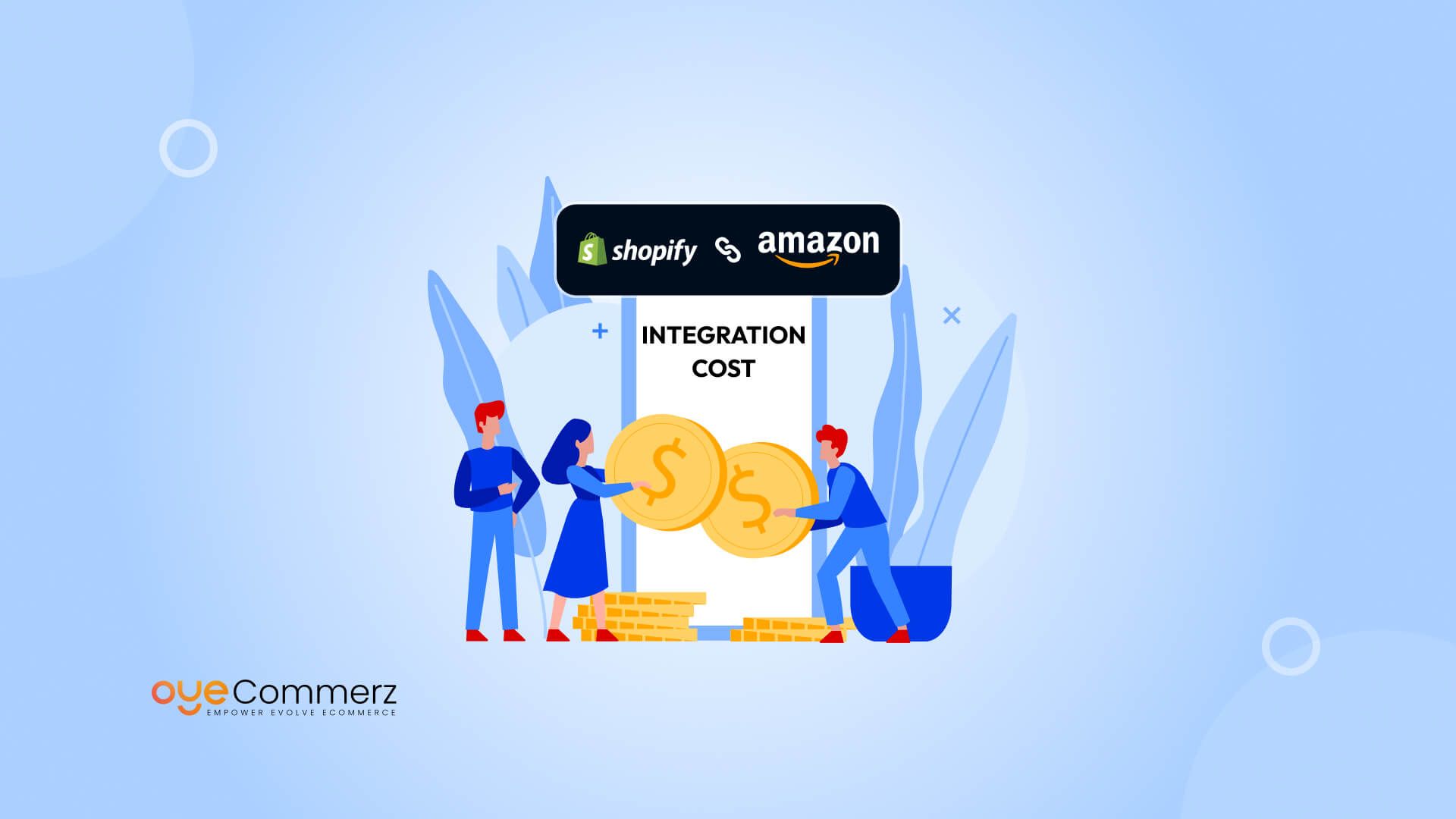As competition grows, multichannel selling has emerged as the key to expanding reach and increasing revenue. Among the most popular combinations is Shopify Amazon integration, a powerful duo that lets sellers tap into Amazon’s massive customer base while retaining the flexibility and branding of Shopify.
For many Shopify store owners, Amazon represents an irresistible opportunity: more visibility, more customers, and potentially, more sales. But with that opportunity comes an important question, what is the true integration cost?
It’s not just about a one-time setup. There are hidden fees, subscription charges, app costs, and potential pitfalls that can catch sellers off guard. This blog breaks down everything you need to know, from integration tools to cost breakdowns and tips to make your investment worthwhile. If you’re thinking of connecting Shopify and Amazon, this is the guide for you.
Table of Contents
ToggleWhy Sell on Both Shopify and Amazon?
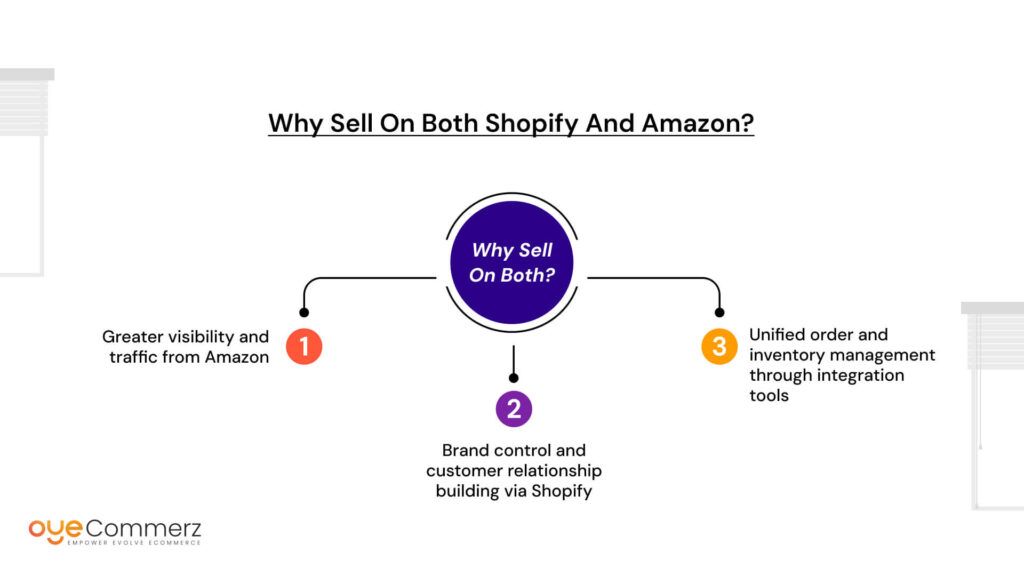
Relying on a single sales channel can limit your growth. That’s where Shopify Amazon integration comes into play. By combining the world’s most popular eCommerce marketplace with one of the most customizable storefront platforms, you unlock the power of multichannel selling.
Here’s why sellers are combining both:
- Amazon = Trust and Traffic
Amazon attracts over 2.4 billion monthly visits. It’s where people go when they’re ready to buy. Selling here means immediate exposure to a global audience that already trusts the platform. - Shopify = Brand and Control
Shopify gives you complete control over your brand’s look, feel, and experience. It’s where loyal customers land, where your email list grows, and where repeat purchases happen.
By integrating the two, sellers enjoy the best of both worlds:
- Greater visibility and traffic from Amazon
- Brand control and customer relationship building via Shopify
- Unified order and inventory management through integration tools
Let’s say…
You’re running a Shopify store selling eco-friendly water bottles. Business is steady, but growth is slow. You decide to list your bestsellers on Amazon. Within a month, you start seeing more orders from Amazon’s search traffic, people who would’ve never found your Shopify store. Thanks to integration, inventory levels sync automatically between both platforms. No overselling. No duplicate order headaches.
Now, instead of just managing one storefront, you’re leveraging two, without doubling your workload.
Challenges of running both separately:
- Updating product info on both platforms manually
- Risk of overselling when inventory isn’t synced
- Double the effort in handling orders and returns
- Higher chances of human error
That’s why Shopify Amazon integration is more than just a trend, it’s a strategic move. But, before jumping in, it’s important to understand how this convenience comes with a price tag, which is what we’ll explore next when we dive into the integration cost and how it breaks down. Understanding the Shopify vs Amazon selling model comparison also plays a key role in choosing the right path for your business.
Understanding the Basics of Shopify-Amazon Integration
Before diving into the numbers, it’s important to understand what the process of connecting Shopify and Amazon actually involves. Many new sellers assume it’s as simple as flipping a switch, but there are several moving parts that work together to make integration smooth and efficient.
At its core, integrating both platforms means syncing your inventory, orders, and listings so that data flows automatically between your Shopify store and your Amazon seller account. This reduces manual work, avoids stock discrepancies, and helps maintain consistency across both channels.
Here’s what a basic integration usually covers:
- Inventory Sync – Updates product stock automatically when an item sells on either platform.
- Order Sync – Automatically pulls Amazon orders into your Shopify dashboard.
- Listing Sync – Lets you publish or update products from Shopify directly onto Amazon.
There are two ways to make this connection:
- Native Integration
Shopify offers a built-in Amazon sales channel (limited to specific regions), allowing for direct sync without extra software. It’s simple, but it has limitations in terms of customization and supported features. - Third-Party Integration Tools
Apps like CedCommerce, LitCommerce, or Codisto offer more flexibility, advanced syncing options, and support for global marketplaces. They often come with additional setup and subscription costs, which will factor into the total integration cost.
Supported Regions
Shopify’s native integration currently supports Amazon marketplaces in:
- United States
- Canada
- Mexico
For sellers operating in the UK, Europe, or Asia, third-party apps become essential.
What You’ll Need Before You Start:
- Amazon Professional Seller Account – Required for API access and listing through Shopify.
- Product GTINs (barcodes) – Amazon requires these for listing most products.
- Compliant Product Listings – Follow Amazon’s strict guidelines on titles, images, and descriptions to avoid rejections.
Understanding these basics not only sets realistic expectations but also helps you decide what tools and strategies you’ll need, especially when it’s time to evaluate whether the investment is worth it.
Core Cost Elements of Integration
Now that you understand how Shopify and Amazon can work together, it’s time to break down the actual costs involved in making it happen. While the idea of running your business across two platforms is exciting, it’s essential to evaluate the financial commitment required upfront and over time.
1. Amazon Professional Seller Plan
To list your products on Amazon, you need a Professional Seller account, which costs $39.99/month. This plan gives you access to all the necessary tools for integration, including API access and bulk listing features. It’s non-negotiable if you plan to sync your inventory and orders efficiently.
2. Shopify Monthly Plan
To run your online store, you’ll also need an active Shopify subscription. Here’s what you can expect:
- Basic Plan: $39/month – great for small businesses just getting started
- Shopify Plan: $105/month – offers better reporting and lower transaction fees
- Advanced Plan: $399/month – suited for high-volume sellers who need advanced analytics and shipping discounts
Your choice here depends on how big your operation is and what features you truly need.
3. Third-Party App Costs
If you’re not using Shopify’s native tools (or need access to more marketplaces), third-party apps become essential. These apps handle syncing, order flow, and inventory management seamlessly. Popular options include:
- CedCommerce – Free to $49/month, depending on features
- LitCommerce – Starts at $29/month
- Codisto – Ranges from $29 to $99/month
These apps simplify multi channel operations but can quickly add to your integration cost if you choose higher-tier plans or multiple channels.
4. Developer or Setup Fees
If you’re not technically inclined, hiring a developer can help with setup or troubleshooting:
- One-Time Setup Fee: $100–$500 depending on complexity
- Ongoing Support or Customization: $50–$150/hour
While not always necessary, these costs are worth considering if you want a hands-off setup or plan to scale aggressively.
By understanding these core expenses, you can make smarter decisions and avoid being caught off guard later. Knowing where your money goes upfront ensures your business stays profitable, even as you expand to new platforms.
Popular Integration Tools: Features vs Pricing
When Shopify’s native integration with Amazon isn’t enough, or you need more flexibility, third-party tools can bridge the gap. These apps automate most of the heavy lifting: syncing inventory, updating listings, and importing orders across platforms. But they come at different price points, with different capabilities.
Here’s a simplified comparison of the top three tools used by sellers:
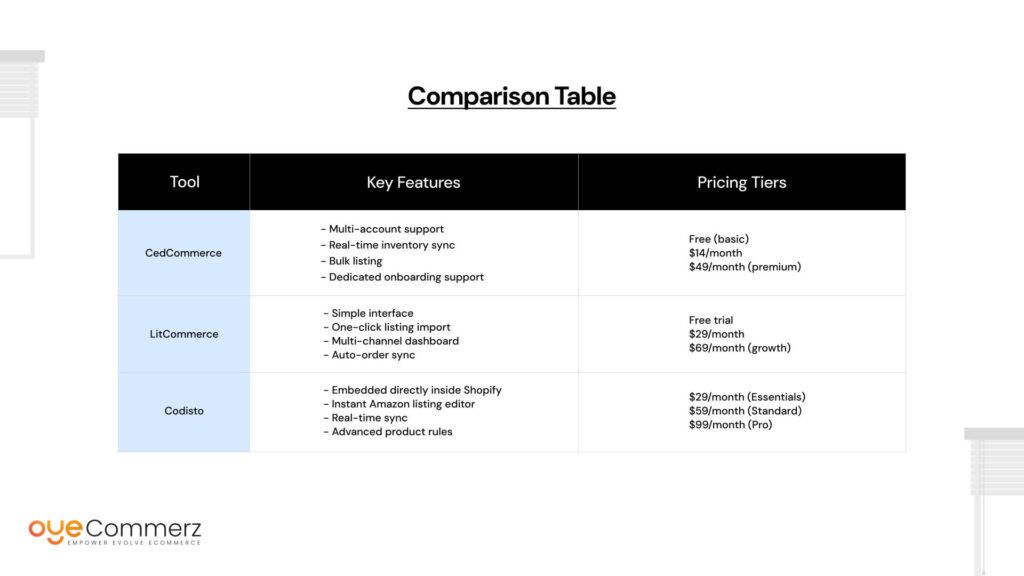
Let’s break it down:
CedCommerce
- Great for sellers managing multiple marketplaces (Amazon, eBay, Walmart, etc.)
- Offers one-on-one onboarding sessions
- Slightly more complex interface for beginners
LitCommerce
- Beginner-friendly and affordable
- Unified dashboard for Amazon, Etsy, eBay, and others
- May lack deeper customization options for large catalogs
Codisto
- Natively integrates inside Shopify’s backend
- Offers advanced listing control and real-time data flow
- Best suited for medium to large businesses needing control and speed
Pros & Cons of Using Third-Party Apps
Pros:
- Save time through automation
- Avoid manual errors in inventory and order syncing
- Access to global marketplaces beyond Amazon US
- Scalable as your business grows
Cons:
- Monthly costs add up, especially with premium plans
- Learning curves can be steep for some apps
- Occasional syncing delays or API issues (depends on platform)
Choosing the right integration app depends on your business size, goals, and technical comfort. Each offers value, but understanding how their pricing aligns with features ensures you’re not overspending for tools you won’t fully use.
Hidden & Unexpected Costs You Might Miss
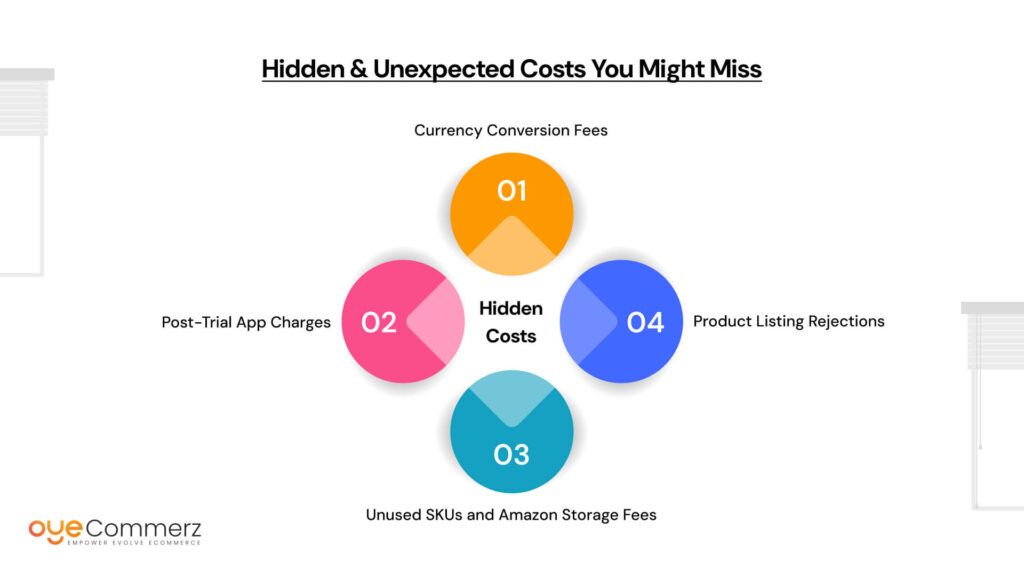
Shopify Amazon integration offers many benefits, but there’s more to the story than what most blogs share. While upfront pricing may look straightforward, hidden or unexpected costs can add up fast, especially for sellers not paying close attention.
Here are some of the most overlooked expenses:
1. Currency Conversion Fees
Selling internationally through Amazon often means receiving payments in different currencies. These get converted into your local currency, with banks or payment processors charging 1%–4% per transaction. Over time, these deductions can significantly reduce your profits.
2. Post-Trial App Charges
Many third-party integration tools offer a free trial. However, once that trial ends, charges begin, often automatically. If you don’t monitor your app usage, you might be paying for features you’re not even using anymore.
3. Unused SKUs and Amazon Storage Fees
With Shopify Amazon integration, it’s tempting to list a large number of products. But be careful, Amazon charges storage fees for items that sit in warehouses unsold. If you’re using Fulfillment by Amazon (FBA), long-term storage costs can stack up quickly.
4. Product Listing Rejections
Amazon has strict guidelines. Listings can be rejected due to non-compliance, like missing GTINs, incorrect images, or vague descriptions. Fixing these takes time, or money if you outsource the rework. It’s often an overlooked integration cost that hits small sellers hard.
Being aware of these hidden costs prepares you to avoid surprises and manage your budget wisely. It’s not just about syncing systems, it’s about maintaining profitability in the long run.
Integration Cost: Do-It-Yourself vs Hiring a Pro
When planning your Shopify Amazon integration, one big decision is whether to handle the setup yourself or outsource the task. Both paths have pros and cons, and the right choice depends on your skills, time, and business complexity.
Let’s explore both approaches:
Do-It-Yourself (DIY)
Doing it yourself is cost-effective, especially for startups. With enough time and willingness to learn, you can use apps like CedCommerce or Codisto to connect platforms manually.
Pros:
- Low to no additional cost
- Learn your systems inside-out
- Flexible setup pace
Cons:
- Can take 10–20 hours or more
- Requires patience and technical comfort
- Risk of setup errors
Hiring a Freelancer or Agency
If you’re short on time or managing many products, hiring a pro might make sense. It reduces hassle and often results in cleaner, faster integration.
Pros:
- Saves time
- Professional quality
- Support for complex issues
Cons:
- Can be expensive
- May require ongoing payment for support
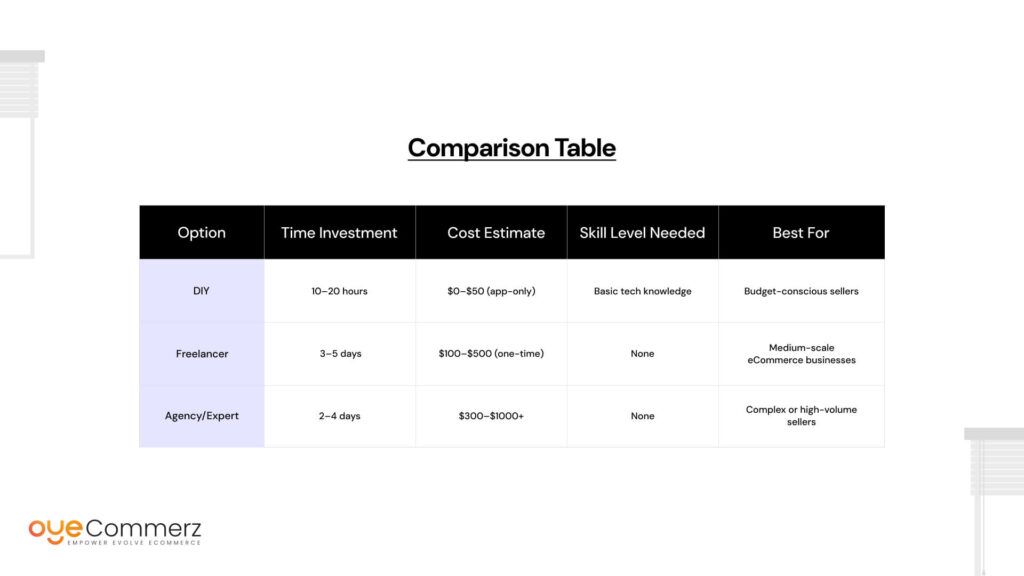
Regardless of the method you choose, always factor in the full integration cost, including time, effort, and the potential for future support. For some, DIY may be empowering; for others, outsourcing ensures peace of mind and professional execution.
Cost-Efficiency Tips: How to Save Money While Integrating
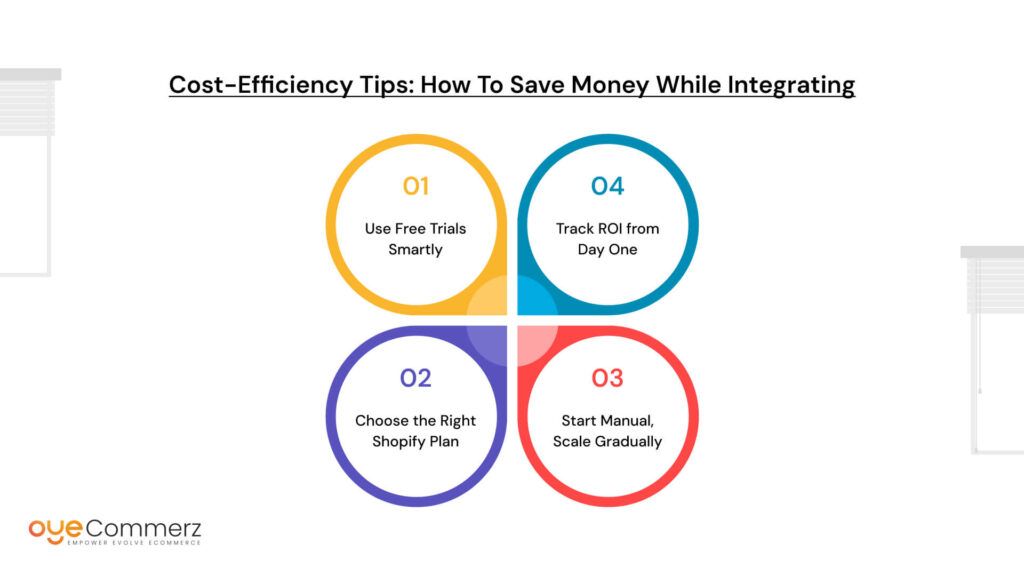
Whether you’re just starting out or scaling up, managing the integration cost smartly can help you get the most value out of your Shopify Amazon integration. Here are some practical strategies to stretch your budget while maintaining efficiency:
1. Use Free Trials Smartly
Many integration apps offer 7 to 14-day free trials. Don’t rush to activate them. Prepare your products and listings first, and then begin the trial so you can test features effectively within the time window.
2. Choose the Right Shopify Plan
It’s tempting to jump to a higher-tier Shopify plan, assuming it’ll give better functionality. But be cautious. If you don’t need advanced reports or multiple staff accounts, stick with the Basic or mid-level plan. Don’t pay for features you’re not using.
3. Start Manual, Scale Gradually
At the beginning, consider syncing orders and inventory manually—especially if you’re only selling a few SKUs. As your business grows and volume increases, move to a paid app for automation. This staged approach helps control early costs.
4. Track ROI from Day One
If you’re spending $50/month on an integration app, make sure it’s delivering results. Use Shopify and Amazon analytics to monitor where orders are coming from, average revenue per channel, and how much time the app is saving you.
Cost-efficiency doesn’t mean cutting corners, it means making smarter choices. Your Shopify Amazon integration should pay for itself in time saved, reduced errors, and additional revenue. A few smart adjustments can prevent wasted spend while still letting you operate at full power.
Is It Worth the Cost? ROI Analysis with Examples
When considering Shopify Amazon integration services, it all comes down to ROI, is the money you want to spend on setup, apps, and tools worth what you earn in return? Let’s break it down with a few relatable examples and some realistic expectations.
Scenario A: Small Seller – $1,000/month on Amazon
Let’s say you’re using a $39 Shopify plan and a $50/month integration tool. Your total integration cost = $89/month.
If Amazon brings in $1,000/month in sales, that’s about 9% spent on integration. That might sound high, but consider the time saved in syncing inventory, reducing errors, and boosting customer trust through fast fulfillment.
Now factor in repeat buyers or reviews gained, your long-term value increases even if the initial profit margin seems small.
Scenario B: Mid-Sized Seller – $5,000/month
Now imagine your store generates $5,000/month from Amazon. That same $89 cost now represents just 1.8% of your revenue. In this case, the integration easily justifies itself, especially as it supports scaling without needing to hire extra staff.
When It May Not Be Worth It
- You sell niche products with limited demand on Amazon
- Your profit margins are razor-thin
- You only sell a handful of items each month
In such cases, the return on your Shopify Amazon integration might not justify ongoing costs. Manual syncing or focusing only on Shopify could be more practical.
Long-Term Gains to Consider
- Exposure to Amazon’s massive customer base
- Brand building across two trusted platforms
- The ability to test product-market fit more effectively
Ultimately, integration isn’t just a tool, it’s a growth decision. When managed well, the return can far outweigh the monthly investment.
Ready to take your eCommerce business to the next level?
Let OyeCommerz handle your Shopify Amazon integration with ease, efficiency, and expertise. From setup to scale, we simplify every step so you can focus on selling more.
Get in touch today and experience seamless multi channel growth like never before!
Let's build your custom Shopify app today!
Conclusion
Shopify Amazon integration isn’t just a technical setup, it’s a strategic move toward smarter, scalable eCommerce. By connecting your Shopify storefront with Amazon’s massive marketplace, you’re not only expanding reach but also unlocking operational efficiency and customer trust. Yes, the integration cost can vary based on the tools, setup method, and scale of your business. But knowing where your money goes gives you the power to plan better and invest wisely.
Whether you’re a solo entrepreneur testing the waters or a growing brand looking to streamline multichannel sales, this integration can offer a serious competitive edge. The key is not just choosing the cheapest option, but the one that delivers real value over time.
In the end, don’t focus only on what integration costs, focus on what it makes possible. When done thoughtfully, it can be one of the smartest investments you make for your business growth.
Frequently Asked Questions
Yes, you can integrate Shopify with Amazon to sync inventory, orders, and product listings across both platforms.
Amazon doesn’t pay Shopify; instead, sellers use integration tools to connect both platforms and manage sales.
Shopify Marketplace Connect is free to install, but may charge fees based on features or usage depending on your plan and needs.
Yes, with Amazon Multi-Channel Fulfillment (MCF), Amazon can fulfill Shopify orders if your products are stored in Amazon’s warehouses.
Selling on Amazon requires a Professional Seller Plan at $39.99/month, plus referral fees per sale (usually 8–15%).

